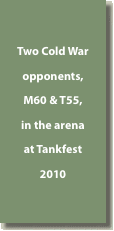
The cauldron of the Second World War forced tank technology and tactics on at a rapid pace. There was no longer a choice between speed and armour or armour and firepower. All had to be in one package. So the concept of the Main Battle Tank started to emerge: a tank with sufficient armour, armament and speed to perform the tasks formerly done by both Infantry and Cruiser tanks (in British terminology).
The British Centurion , rushed to Germany in the last days of the war, but which never saw action, was the first of the line. The American M26 Pershing, delayed by political in-fighting in the US Military, did see action in 1945, and the Russians had been building the IS range of heavy tanks for over a year.
Initially, post-war development was slow: the money was needed for reconstruction. So WW II tanks were maintained. Increasing Cold War fears and finally the Korean War sparked rearmament and further development. British development saw the successful evolution of the Centurion, progressively up-gunned and improved, and then from (date) the Chieftain.
The Russian mainstay was the T54/55, which served in all the Eastern Bloc armies and many overseas client armies such as Egypt, Syria and China.
From the early M26 Pershing, US developments saw an evolution through the M47 and M48 Patton series to the M60, which became the main AFV of many NATO armies. M60s have seen action in South East Asia, The Middle East and India.
Beginning in the 1950s, Germany began to recreate an army within NATO which initially used US tanks. Soon, however, they embarked on the development of their own vehicle after a collaborative venture with the French came to nothing. This resulted in the excellent Leopard, whose design process featured many of the names associated with earlier German tank development: Porsche, Wegmann, Rheinmetall, Henschel and Atlas-MAK . This then evolved into the superlative Leopard II which is still in service today.
Rapid technological development permitted the creation of more powerful and reliable engines, delivering in excess of 1,000HP. This was needed as weights grew inexorably to more than 60 tons. Gun calibres and technologies also increased but settled finally in the 105mm-120mm range, some featuring fin-stabilised munitions and smooth bore guns.
Gun stabilisation systems permitted very accurate shooting on the move. But all this was costly, and with the growth of anti-tank missiles, questions started to be raised about the continued role of the tank, and a quest was on for alternatives. The Swedish S tank is one interesting example, featuring no turret but a fixed gun (rather like the German StuG before) and a very low profile.
East West tension fuelled these developments, as it did elsewhere in defence technologies , so when the Berlin Wall came down and the Communist Bloc disintegrated, once again a question mark hung over the tank.
